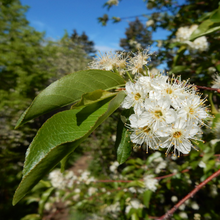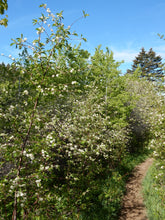Prunus emarginata
Bitter cherry is an attractive, mid-sized, deciduous tree with a rounded form, that is beloved by insects and wildlife. It is estimated to be a caterpillar host and larval food source for around 150 species of native butterflies and moths! Hummingbirds, native bees and European honey bees alike will forage wildly on its clusters of almond-scented white flowers. Pollinated flowers then develop into abundant small red fruits in summertime that birds will flock to, particularly Cedar Waxwings. As summer fades, the leaves take on a nice yellow-ish fall color before dropping to the ground to participate in the dynamic dance of decomposition and provide habitat to countless species of arthropods (that are, in turn, food for ground-foraging birds, like thrushes, and amphibians). The bare winter trunks and stems have reddish-brown bark with visible horizontal lenticels, raised pores that allow for gas exchange between the tree and the surrounding air.
- Plant type/canopy layer: deciduous, perennial, mid-sized tree
- Size at maturity: 30’ - 80’ tall (though usually no more than 50’), 20' wide (canopy)
- Light requirements: full sun, part-sun/part-shade
- Moisture requirements: moist to wet soil
- Bloom time: April - June
- Growth rate/ease: fast growing, moderately easy to grow
- Wildlife support: fruits are an important food source for birds and small mammals; leaves and twigs are browsed by deer, elk and black bear; overall plant is a caterpillar host and larval food source for around 150 species of native butterflies and moths including the Western Tiger Swallowtail, Lorquin's Admiral and Elegant Sheepmoth
- Native habitat/range: common in rocky slopes and mixed forests at mid-to-alpine elevations from southern British Columbia to southern California along the coast through the Cascades and Sierra Nevadas; east to the Rocky Mountains of Montana and Idaho, and in isolated communities in New Mexico, Arizona, Utah and Wyoming. Portland Plant List - yes.
- Special features & uses: supports hummingbirds; wildlife favorite; pollinator favorite; landscape uses include bank stabilization/erosion control, habitat hedgerows, wildlife gardens, pollinator gardens; woodland gardens; cherry bark, stems and twigs are very decorative and useful in basketry and have been used by indigenous people in this way, and for wrapping the joints of many implements, such as spears, arrows and fire drills for tens of thousands of years.
Gardening with Bitter Cherry: With its attractive bark, flowers and fruit, bitter cherry can be a lovely addition to full or partially sunny areas of the habitat garden. It tolerates clay soils, but will thrive in more loamy or rocky areas with medium to slow drainage that are nutrient-rich. It requires very little, if any, supplemental water once established. Watch out for suckers over time, as this species wants to develop into a flowering thicket and a veritable haven for wildlife.
Photo Credits: "Prunus emarginata" by Matt Lavin is licensed under CC BY-SA 2.0




